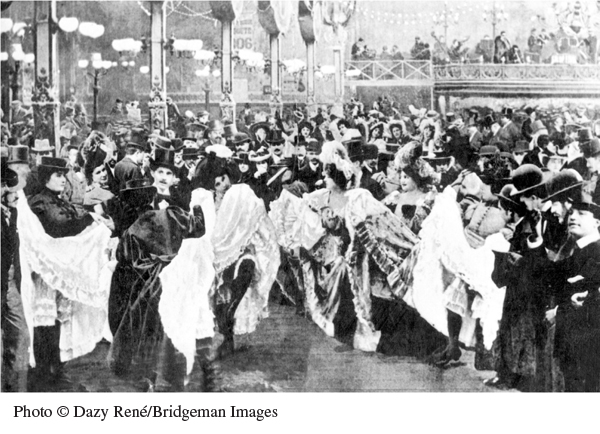A History of Western Society: Printed Page 734
A History of Western Society, Value Edition: Printed Page 702
A History of Western Society, Concise Edition: Printed Page 731
Chapter Chronology
Working-Class Leisure and Religion
Notwithstanding hard physical labor and lack of wealth, the urban working classes sought fun and recreation, and they found both. Across Europe, drinking remained unquestionably the favorite leisure-time activity of working people. For many middle-class moralists, as well as moralizing historians since, love of drink was the curse of the modern age — a sign of social dislocation and popular suffering. Certainly, drinking was deadly serious business. One English slum dweller recalled that “drunkenness was by far the commonest cause of dispute and misery in working class homes. On account of it one saw many a decent family drift down through poverty into total want.”6
Generally, however, heavy problem drinking declined in the late nineteenth century as it became less socially acceptable. This decline reflected in part the moral leadership of the labor aristocracy. At the same time, drinking became more publicly acceptable. Cafés and pubs became increasingly bright, friendly places. Working-class political activities, both moderate and radical, were also concentrated in taverns and pubs. Moreover, social drinking in public places by married couples and sweethearts became an accepted and widespread practice for the first time. This greater participation by women undoubtedly helped civilize the world of drink and hard liquor.
Page 735
The two other leisure-time passions of working-class culture were sports and music halls. “Cruel sports,” such as bullbaiting and cockfighting, still popular in the middle of the century, had greatly declined throughout Europe by the 1880s. Commercialized spectator sports filled their place; horse racing and soccer were the most popular. Working people gambled on sports events, and for many a working person a desire to decipher racing forms provided a powerful incentive toward literacy. Music halls and vaudeville theaters, the working-class counterparts of middle-class opera and classical theater, were enormously popular throughout Europe. In 1900 London had more than fifty such halls and theaters. Music hall audiences included men and women, which may account for the fact that drunkenness, premarital sex, marital difficulties, and mothers-in-law were all favorite themes of broad jokes and bittersweet songs.

Moulin Rouge A group of barmaids perform the French cancan in 1895 at the Moulin Rouge, a famous Parisian cabaret/nightclub, while a live orchestra plays in the balcony above. The cancan was a fast and provocative dance that involved rapid dips and turns, and high kicks that revealed the performers’ legs and frilly underwear. The new industrial society made leisure time available to more and more people of all classes, and mixed-couple entertainment including dance balls, theater performance, and dining out became increasingly popular.
(Photo © Dazy René/Bridgeman Images)
In more serious moments, religion continued to provide working people with solace and meaning. The eighteenth-century vitality of popular religion in Catholic countries and the Protestant rejuvenation exemplified by German Pietism and English Methodism (see Chapter 18) carried over into the nineteenth century. Indeed, many historians see the early nineteenth century as an age of religious revival. Yet historians recognize that by the last few decades of the nineteenth century, a considerable decline in both church attendance and church donations had occurred in most European countries. And it seems clear that this decline was greater for the urban working classes than for their rural counterparts or for the middle classes.
Why did working-class church attendance decline? On one hand, the construction of churches failed to keep up with the rapid growth of urban population, especially in new working-class neighborhoods. On the other, throughout the nineteenth century workers saw Catholic and Protestant churches as conservative institutions that defended status quo politics, hierarchical social order, and middle-class morality. Socialist political parties, in particular, attacked organized religion as a pillar of bourgeois society; and as the working classes became more politically conscious, they tended to see established churches as allied with their political opponents. In addition, religion underwent a process historians call “feminization”: in the working and middle classes alike, women were more pious and attended service more regularly than men. Urban workingmen in particular developed vaguely antichurch attitudes, even though they might remain neutral or positive toward religion itself.
Page 736
The pattern was different in the United States, where most nineteenth-century churches also preached social conservatism. But because church and state had always been separate and because a host of denominations and even different religions competed for members, working people identified churches much less with the political and social status quo. Instead, individual churches in the United States were often closely identified with an ethnic group rather than a social class, and churches thrived, in part, as a means of asserting ethnic identity. This same process occurred in Europe if the church or synagogue had never been linked to the state and served as a focus for ethnic cohesion. Irish Catholic churches in Protestant Britain, Catholic churches in partitioned Polish lands, and Jewish synagogues in Russia were outstanding examples.
